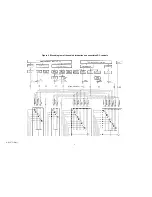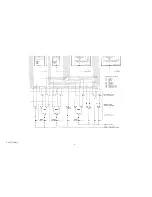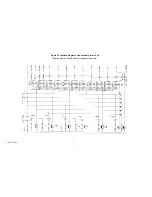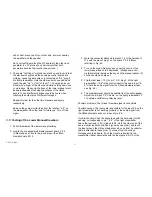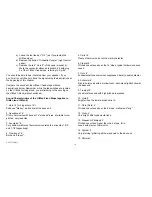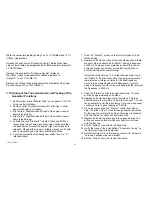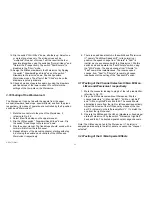
read +15 V DC and 15 V DC respectively. Both voltages
should be correct /-1VDC.
Possible problems:
One or both voltages are missing or read well
below the 1 5 Volts.
Possible cause:
A short circuit in any of the organ's subunits that
use this voltage.
Trouble-shooting:
Unplug all connectors on the power supply
leading to the pins of the voltage in question. Do not remove any
connectors leading to " G N D ". Turn on the organ again and verify
the presence of the proper voltage. It is very likely that it will be
there since the power supply was found to be in good working
condition earlier. Re-connect the connectors one by one while
constantly monitoring the voltage. The connector which, when
mated, causes the voltage to collapse, obviously contains the wire
with the short circuit. Consult the wire list to locate all possible
"users" of this voltage. Check for a short circuit (using the
ohmmeter and looking for a very low resistance, e.g., less than 10
Ohms) at each point where the supply voltage is used. (The
connector which contains the wire with the trouble is to be
disconnected from the power supply during this test.) After the
subunit is located which presents a short circuit to the power
supply, consult the respective assembly manual for assistance to
the troubleshooting on the subunit proper.
In any case, the power supply voltages must be at their
proper values with all supply wires connected. Anything that
impedes this must be located and rectified before any subsequent
tests are meaningful.
2. Prepare another 40" long piece of hookup wire by removing
the insulation at both ends over a length of about 1/4".
Attach a 1" long piece of heavy bare hookup wire to one end
of this wire. Stick the end with the bare wire into the rear
opening of the connector on the left preamplifier, namely into
the hole with leads to pin "A 2" on plug 5. This location
corresponds to the audio output of the left preamplifier (=
audio input of the left power amplifier).
Turn on the organ and touch the other end of this wire with
your hand. The formerly faint noise from the left speaker
should become more pronounced. This test verifies the
continuity of the audio output line all the way from the
preamplifier to the speaker.
Plug the lead with the bare piece of wire into the opening
corresponding to "A 2" of plug 5 on the right preamplifier.
Again, touch the other end of the wire. The increased noise,
this time, should come from the right speaker.
Leave the wire connected to "A 2", plug 5 on the right
preamp. Hold the other end of the wire with one hand and
run a finger of the other hand along the foil side of the gating
boards G 2 on either tone generator. All sorts of tones
should be heard at a certain volume which depends on
whether you have dry or moist skin. The "bridging" action of
your body between the tone generator and the power
amplifier is totally harmless. However, should you be
reluctant to lend your body as a part of the test circuit, delete
this test altogether. Under no circumstances must you touch
any circuit components directly with the audio monitor lead.
The power amplifiers are designed to accept millivolts (a few
thousandths of a volt) for full output power. The voltages in
the organ (including the tone generator) range u p to 15
Volts. Applying that kind of a signal to the power amplifier
AM 075 (Part)
10
Содержание GALAXY
Страница 1: ...Master Assembly GALAXY AM 075 AM 075 Part 1 ...
Страница 4: ...Figure 1 Layout of the building blocks in the organ top AM 075 Part 4 ...
Страница 5: ...Figure 2 Block diagram of the audio distribution and associated DC controls AM 075 Part 5 ...
Страница 6: ...AM 075 Part 6 ...
Страница 33: ...Figure 4 Schematic layout of the wiring harness GO 4 AM 075 Part 33 ...





